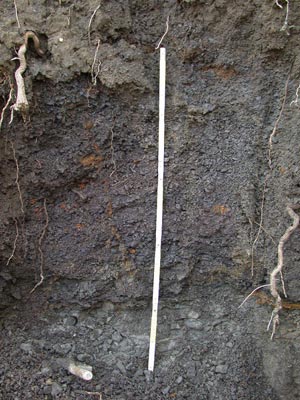| Details of the GSSP at El Kef. Slabs mounted in epoxy resin. Scale
on the right in cm. From bottom to top: A) uppermost Maastrichtian. Frequent
burrows are visible as dark stains, filled with dark clay from the Danian.
B) Leached topmost Maastrichtian, containing only casts of Maastrichtian
foraminifers. C) Reddish ejecta layer, rich in iridium, altered microkrystites
(sanidine, smectite and goethite) and Ni-rich spinels. GSSP is at the
bottom of the layer. D) Basal part of the dark boundary clay layer. Graded
(see here). Still rich in Cretaceous foraminifers and contains
occasional sanidine and goethite spherules (microkrystites). E) Basically
carbonate free and foraminifer free clay, except some arenaceous benthic
foraminifers (2 cm) F) interval relatively (<100%) rich in very small,
irregular guembelitriids, besides benthic foraminifers. G) irregular
layers of sub-recent gypsum or anhydrite crystals. One of the problems
of all the Tunisian K/Pg sections is their ubiquitous presence at exactly
the iridium rich red layer, where they replace partially the ejecta layer,
and clay above and below |
